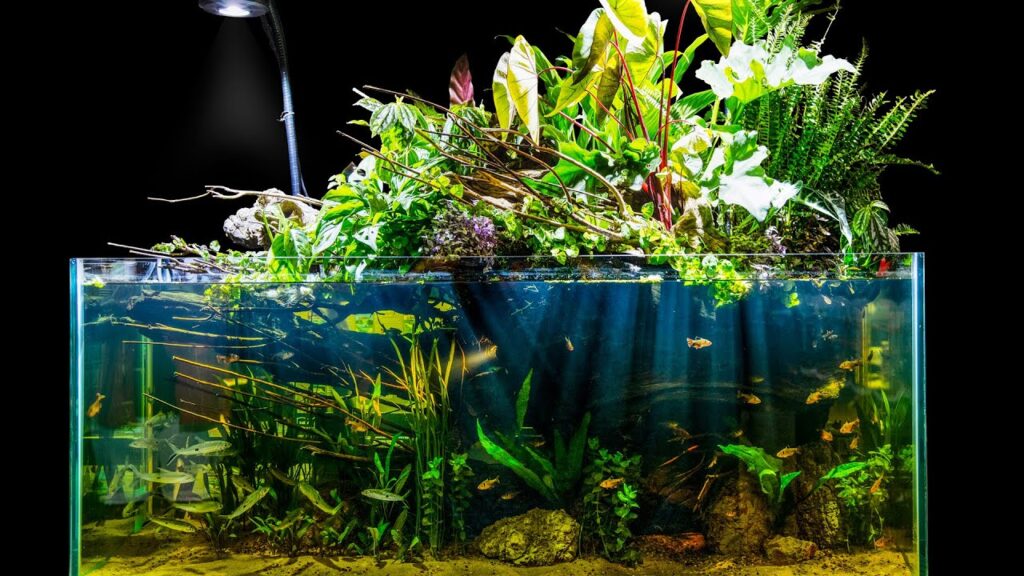
Riparium Aquarium Style: Bridging Land and Water in Aquatic Design
Aquarium enthusiasts and aquascapers are continuously pushing the boundaries of creativity, seeking new ways to replicate natural ecosystems within the confined spaces of glass tanks. One such innovative approach that has gained prominence is the “Riparium Aquarium Style.” This unique design method blurs the line between aquatic and terrestrial environments, allowing aquarists to cultivate both submerged and emerged plant life alongside aquatic inhabitants. Ripariums offer a captivating blend of underwater serenity and above-water lushness, fostering a miniature world where land and water coexist harmoniously.
Understanding Riparium Aquarium Style:
Derived from the Latin term “riparium,” which translates to “river bank,” ripariums mimic the transitional zones found on the edges of water bodies like rivers, lakes, and ponds. In nature, these zones are characterized by a mix of plants that can thrive both underwater and on moist land. The riparium style recreates this dynamic by dividing the aquarium into two distinct zones: the submerged aquatic section and the emerged riparian section.
The submerged section of the tank consists of water with aquatic plants and aquatic inhabitants, similar to a traditional aquarium setup. The real magic of the riparium style unfolds in the emerged section. This section typically includes a raised platform, often using materials like driftwood, rocks, or purpose-built platforms, that protrudes above the waterline. Here, a carefully curated selection of plants that prefer their roots to be partially submerged and leaves to be above the water’s surface is arranged.
Designing a Riparium:
Creating a successful riparium aquarium involves thoughtful planning and a deep understanding of the plant and animal species you intend to include. Here are some key steps to guide you through the design process:
1. Tank Selection and Setup: Choose a tank size that allows ample space for both the aquatic and emerged sections. A tank with a larger footprint provides more creative flexibility. Equip your tank with a reliable filtration system and appropriate lighting to support both aquatic and terrestrial plants.
2. Hardscape Arrangement: Construct the emerged section using hardscape materials like driftwood, rocks, or platforms that rise above the waterline. These elements create the foundation for the riparian zone and offer diverse surfaces for plant attachment.
3. Plant Selection: Select plants that can thrive in both submerged and emerged conditions. Common choices for the emerged zone include peace lilies (Spathiphyllum), pothos (Epipremnum aureum), and various fern species. In the aquatic zone, consider species like Anubias, Cryptocoryne, and Vallisneria.
4. Plant Placement: Strategically position the emerged plants on the elevated platform, ensuring their roots have access to water while their leaves extend above the water’s surface. In the submerged zone, arrange aquatic plants according to their growth habits, with taller species placed at the rear and shorter ones in the foreground.
5. Aquatic Inhabitants: Select fish and other aquatic creatures that complement the riparium setup. Small schooling fish, shrimp, and snails can thrive in the aquatic section, while cautious selection is crucial to avoid disturbing the emerged plants.
6. Maintenance: Regular maintenance is essential to keep the riparium thriving. Prune emerged plants as needed, removing any dead or overgrown parts. Monitor water parameters and perform water changes to ensure a healthy aquatic environment for the inhabitants.
Additional Reading:
Benefits of Riparium Aquarium Style:
Ripariums offer a multitude of benefits, making them a captivating and rewarding choice for aquarists:
1. Biodiversity: The combination of aquatic and emerged plant species encourages a diverse ecosystem, supporting a variety of flora and fauna.
2. Aesthetic Appeal: Ripariums provide a visually stunning contrast between the underwater and above-water environments, adding depth and dimension to the tank.
3. Education and Observation: Ripariums offer an opportunity to observe the interactions between aquatic and terrestrial life, fostering a greater understanding of natural ecosystems.
4. Creative Expression: Designing a riparium allows for artistic expression by arranging plants, hardscape, and aquatic inhabitants in a way that mimics the beauty of nature.
5. Low-Maintenance Option: While maintenance is still necessary, ripariums can be relatively easier to maintain compared to some high-maintenance aquascaping styles.
Challenges and Considerations:
Creating a successful riparium also comes with its set of challenges and considerations:
1. Plant Compatibility: Ensuring that selected plants can thrive in both aquatic and emerged conditions requires careful research and attention.
2. Humidity Control: The emerged section can raise humidity levels around the tank. Adequate ventilation or a humidity-loving plant selection can help manage this.
3. Aquatic Inhabitants: Careful selection of fish and other aquatic creatures is crucial to avoid disturbing the emerged plants and maintaining a balanced ecosystem.
4. Maintenance Balance: Regular pruning and maintenance are necessary for both the aquatic and emerged sections to prevent overgrowth or decay.
In Conclusion:
The riparium aquarium style offers a captivating blend of underwater tranquility and above-water lushness, providing aquarists with a unique opportunity to bridge the gap between aquatic and terrestrial worlds. With careful planning, thoughtful design, and a keen understanding of the plant and animal species involved, enthusiasts can create captivating miniature ecosystems that captivate the eye and educate the mind. A riparium is not just an aquarium; it’s a living masterpiece that showcases the beauty and complexity of nature in a confined glass canvas.






















Add comment